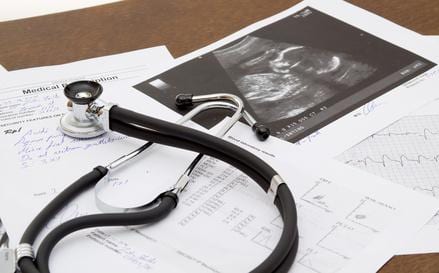Sonograms, commonly referred to as ultrasounds during pregnancy, provide an invaluable look at your growing baby. But the use, especially for moms who must have several during pregnancy, does bring about questions and concerns regarding the safety of this medical technology. To put your mind at ease, know that after more than five decades of use, the normal use of sonograms for medical purposes has never been associated with any harmful effects on fetuses, according to the American Institute of Ultrasound Medicine (AIUM). However, the AIUM does concede that there is always a chance of learning about adverse effects in the future. Therefore, non-medical use of sonograms should be used with caution.
Ultrasound Types
Several types of ultrasounds are available to pregnant women. Some, like the transvaginal ultrasound, allow ultrasound technicians to get a view of the baby very early in pregnancy. Others, such as an advanced ultrasound and fetal echocardiography, use more sophisticated technology to evaluate the growth and development of the baby and his organs better. Unless there are complications or a family history of congenital defects, most women only get a standard ultrasound during pregnancy.
The Procedure
Sonograms use ultrasound, or sound waves, to create a picture of a developing fetus. These sound waves bounce off tissue and bones from the baby, placenta and uterus and form a picture on a computer monitor. The mother lies on her back during the procedure while a technician or doctor runs a small hand-held wand over her womb. The procedure itself is not painful or uncomfortable–except for the full bladder that mom must have to help the technician differentiate internal structures. Some fetuses are still and calm during the procedure, while others kick back at the pressure of the wand.
Purpose
Sonograms are used to monitor the development of the baby, giving doctors and moms vital information. With an ultrasound potential health problems can be detected, amniotic fluid levels monitored, the size of the baby at birth can be estimated and the sex of the baby determined. With pregnancies involving multiple fetuses, the monitoring of growth and development with an ultrasound becomes much more important. The Society for Maternal-Fetal Medicine reports that before 23 weeks of gestational ages, 85 percent of heart defects can be seen by an ultrasound.
Keepsakes Help Bonding
Many clinics now offer 3-D and 4-D ultrasounds that give parents a picture of what their baby really looks like, showing facial features, toes and fingers. These clinics allow any mom to have one of these ultrasounds to create keepsake photos and video. These are not generally used for medical purposes because the organs and bones cannot be seen. The AIUM recognizes the value of having keepsake sonograms stating that there scientific research show 3-D sonography to have positive impact on bonding between the parents and the baby.
Keepsake Concerns
Keepsake ultrasounds are not usually done with the recommendation or referral of the patient’s doctor. The AIUM reports that the FDA has stated that these types of ultrasounds, having no medical value, put mom and baby under unnecessary risks. The concern of the FDA and AIUM is that these types of ultrasounds produce more intense sound waves. Although no studies confirm any harmful effects of these types of ultrasounds, it is also a new technology.
Photo Credit
- doctor desk image by dinostock from Fotolia.com





